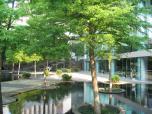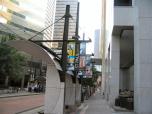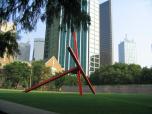




Living through the hot environment of a Dallas summer I am acutely aware of the inhumanity of a July afternoon when the air temperature can reach 105 degrees or greater and the concrete streets in the middle of the urban center are hot enough to fry a variety of foods. I try to embrace the outdoors as much as I can during this time of year, but appreciate that limits exist on my being able to do that, particularly in areas where shade is scarce. To provide for greater shade as well as a variety of other benefits, the City of Dallas has had policies promoting tree preservation for a number of years requiring property owners to account for trees they are removing from land, by either replanting them or contributing to the city’s replanting fund.
When I met Chris Tobaben, a recent Environmental Design graduate of Texas A&M, at a networking event a couple of months ago, and listened to him tell me about a for-profit company he had formed named Gift of Green, LLC to promote his passion of tree planting, I knew I needed to interview him. His tagline is “Gift of Green is an Eco-Friendly alternative to fundraising. We plant trees on behalf of schools and organizations.”
Chuck: How did you get interested in trees?
Chris: My father and I formulated this idea in 2010. He wanted to sell trees to businesses that could give them as gifts to his customers. He and I jointly came up with the idea to promote this endeavor through fundraisers. I pitched this idea to sororities and fraternities at Texas A&M and they were supportive. While I was at A&M, I was in a fraternity focused on architecture and engineering.
Chuck: Now that you are back in the Dallas-Fort Worth area, where do you see the biggest needs as it relates to new tree plantings?
Chris: The whole area was impacted by last year’s drought and needs trees. All areas of Dallas need plantings. The Forest Service is helping here. I am concentrating on Dallas-Fort Worth and Austin, particularly Bastrop in the Austin area. My focus is on doing plantings in parks and high profile public spaces.
Chuck: Where did you receive most of your education as it relates to trees?
Chris: Most of my education about trees came from the internet. I am more of a broker in this deal relying on the Texas Forest Service for information. My education regarding sustainability came from Texas A&M.
Chuck: What education programs currently exist for school children as it relates to trees and the environment?
Chris: There are many programs that kids can go to by taking field trips. Earth Day provides the opportunity for schools to promote concern for the environment.
Chuck: How would you say that your program is different?
I would use my contacts with the Texas Forest Service to bring an urban forester to them.
Chuck: Have they gone into schools?
Chris: They often go into schools. The Tarrant County urban forester goes into certain schools on earth day. However, she is one person and there are many more schools in Tarrant County alone.
Chuck: Does the Texas Forest Service work with others like you?
Chris: There is a group called The Tree Folks in Austin. They find volunteers to plant trees. There are also other small groups around the state.
Chuck: You talk about carbon sequestration. An urban area like Dallas can get very hot in the summertime, yet Dallas wants to encourage more street life and outdoor activity. What would you propose to a city like Dallas that would make it more pleasant to be outside in the daytime during summer?
Chris: I like to look at a city such as Paris where the streets have tree canopies. I can envision many of the streets in Dallas that have retail shopping, restaurants, coffee houses and galleries, with sidewalks lined with tree canopies, patterned in a way to create a consistent look.
According to the Environmental Protection Agency’s website, Carbon Sequestration is described as “…the process through which carbon dioxide (CO2) from the atmosphere is absorbed by trees, plants and crops through photosynthesis, and stored as carbon in biomass (tree trunks, branches, foliage and roots) and soils. The term "sinks" is also used to refer to forests, croplands, and grazing lands, and their ability to sequester carbon. Agriculture and forestry activities can also release CO2 to the atmosphere. Therefore, a carbon sink occurs when carbon sequestration is greater than carbon releases over some time period.”
Chuck: What trees are best for carbon sequestration? Should a city concentrate on planting a certain type of tree to obtain maximum amounts of carbon sequestration?
Chris: That’s hard to say. I rely on the Texas Forest Service here. It depends upon the area where you are. There are many trees that do well. You need to have trees that are natural to the area and not have just one type of tree.
Chuck: What do you think about urban growth boundaries?
Chris: I took a class on urban sprawl at Texas A&M. Houston is very large and spread out. It does not go vertical very much. A city should not spread out just because it can. Dallas, Kansas City and Atlanta have a much smaller skyline than New York City. I am not a fan of urban sprawl.
Culturally speaking I have been impacted by a couple of movies that display the impersonal nature of endless sprawl, the 1997 movie Fifth Element with Bruce Willis, and the 1982 movie, Blade Runner with Harrison Ford.
Chuck: Consider your environmental design education and your passion for trees and the environment. What should a real estate developer do who buys a ten acre piece of land in an urban area with the goal of developing a high rise mixed-use development?
Chris: I would develop the property so as to have the buildings framing the perimeter of the property with the trees in the interior, designed in a park-like setting. On the other hand, I might consider having the trees on the outside of the development on the west and south sides, providing shade, and arranged in a fashion to create an open area where people can walk through.
Chuck: Where do you see yourself in ten years?
Chris: My five year plan would be to design and build a set of homes that are eco-friendly and net zero on energy. (Net-zero means that the energy your structure is putting out equals the amount of energy your structure is taking in.) I would do this in College Station and market these homes to college students. It would be a very sustainable project. If it works there, I would do it in Waco, Austin and other places. These homes would be designed around a common area that would contain a theater, laundry area, pool, etc..I would design these homes with windows on the north side of the structures in order to bring in natural light.
Tree Space
Posted: May 1, 2012 by Chuck DeShazo
